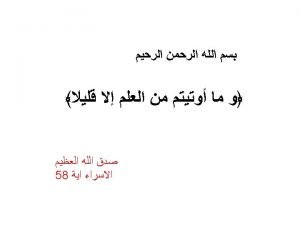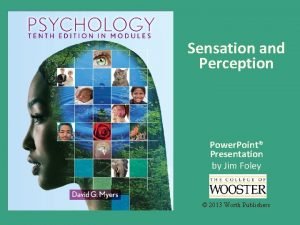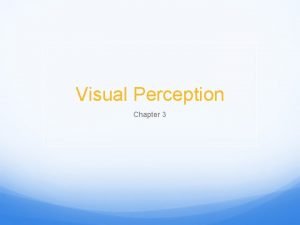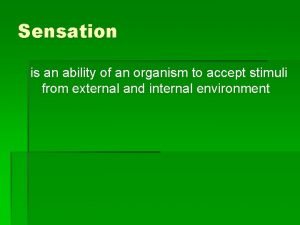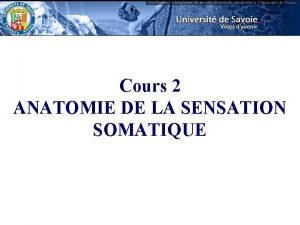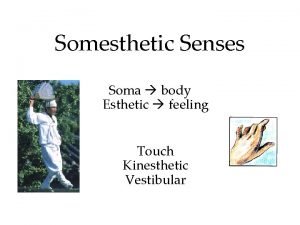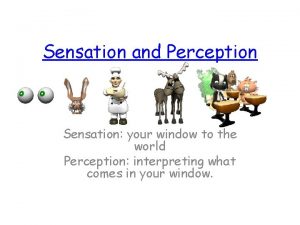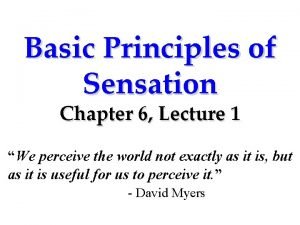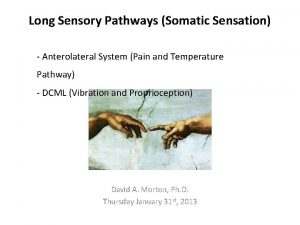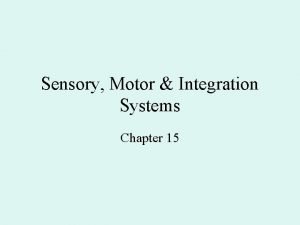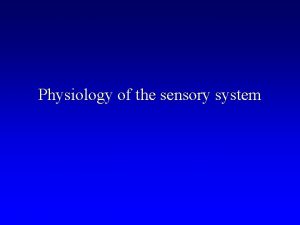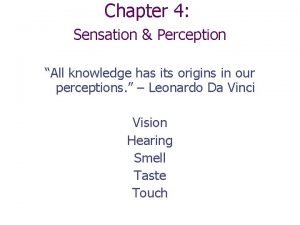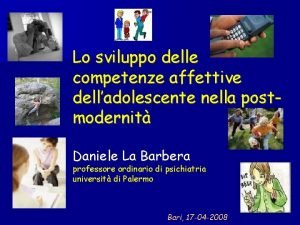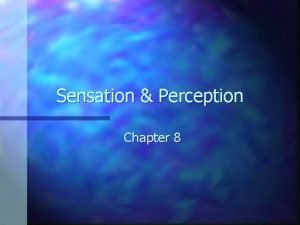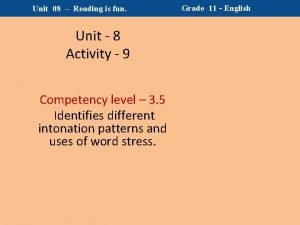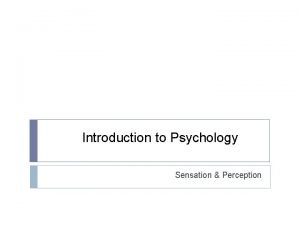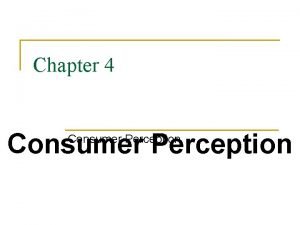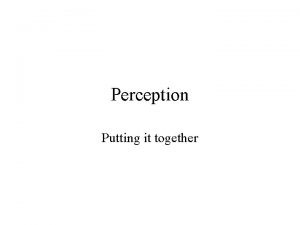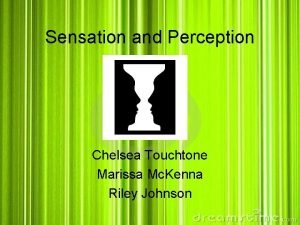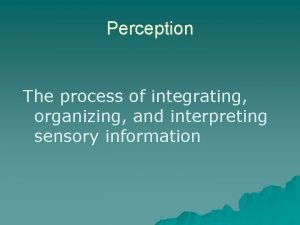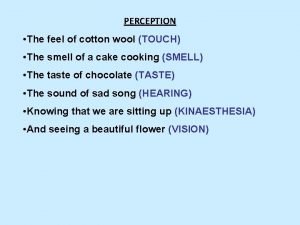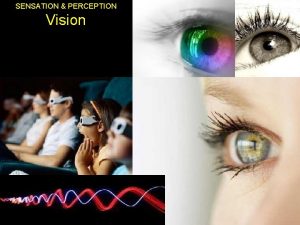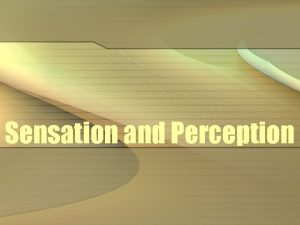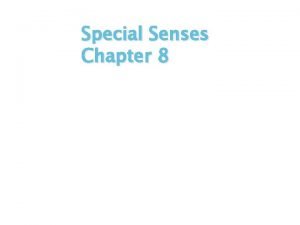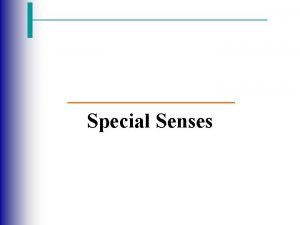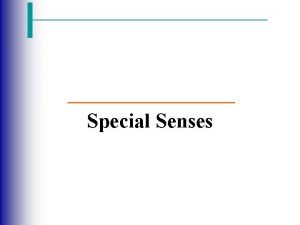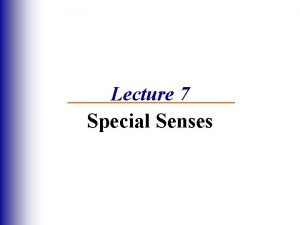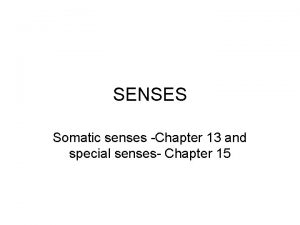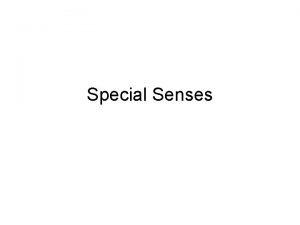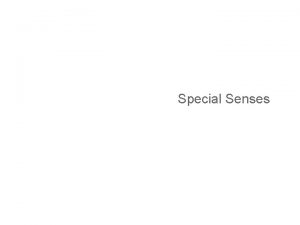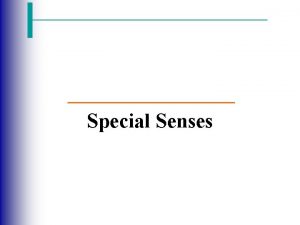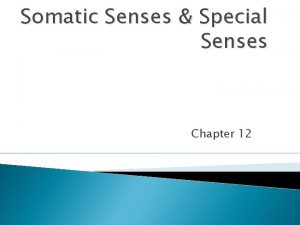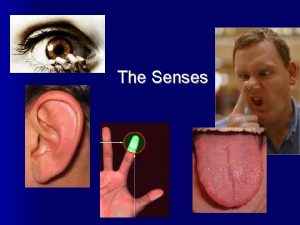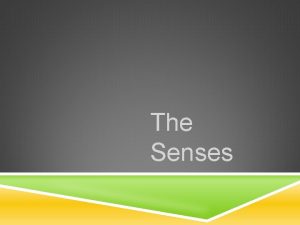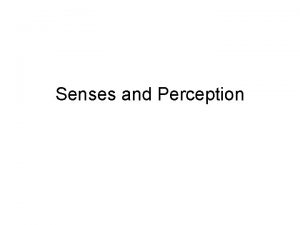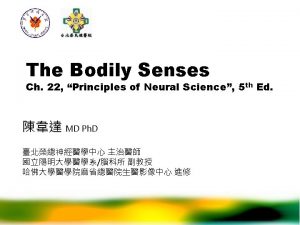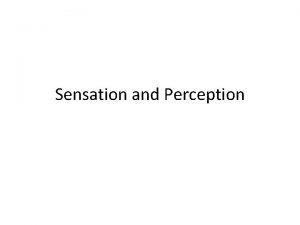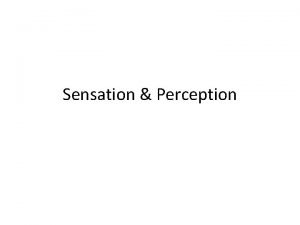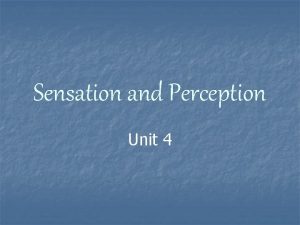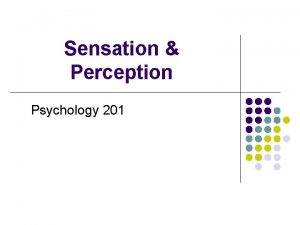Stimulation of the Senses Sensation is the stimulation





































- Slides: 37

Stimulation of the Senses Sensation is the stimulation of sensory receptors and the transmission of sensory information to the central nervous system. Stimulation of the senses is automatic. Perception is the psychological process through which we interpret sensory stimulation. Absolute Threshold Difference Threshold • Absolute threshold is the weakest amount of a stimulus that can be sensed. • The minimum amount of difference that can be detected between two stimuli is knows as the difference threshold. • Absolute thresholds differ from humans to animals and also from person to person. • People’s individual difference thresholds vary slightly.


Sensory Adaptation • Our sensory systems adapt to a changing environment. • Sensory adaptation is the process by which we become more sensitive to weak stimuli and less sensitive to unchanging stimuli. • Examples: – When your eyes adapt to the darkness. – When people adapt to the sounds of city traffic. • Some stimuli do not display this kind of adaptation. – We do not usually adapt to pain.

Signal-Detection Theory • Signal-detection theory is a method of distinguishing sensory stimuli that takes into account not only the stimuli’s strengths but also such variables as: – the setting – your physical state – your mood – your attitudes • It also considers psychological factors such as: – motivations – expectations – learning

Psychology in Today’s World Animal Senses Over the centuries, people have reported that animals appear to have a sixth sense for detecting earthquakes, hurricanes, volcanic eruptions, and tsunamis. In more recent times, animals’ acute senses have been used to help the disabled, find missing persons, and sniff out bombs and drugs. • In December 2004, animals sensed an impending tsunami in the Indian Ocean that struck dozens of Asian and African countries. • Many animals can detect changes in the environment that humans cannot. • Dogs have been shown to accurately predict epileptic seizures. • Dogs can sniff out survivors after a disaster. • A recent study trained wasps to detect many different odors. The training may be used to sniff out bombs and drugs.

Light • Light: electromagnetic energy described in wavelengths • Electromagnetic spectrum: light that is visible to humans and light that is not • The light that humans can see makes up only a small part of the spectrum. • The main colors of the spectrum are: – red – orange – yellow – green – blue – indigo – violet

The Eye • The amount of light that enters the eye is determined by the size of the opening in the colored part of the eye, which is the pupil. • The lens adjusts to the distance of objects by changing its thickness. • The retina is a sensitive surface that consists of neurons. • Neurons that are sensitive to light are called photoreceptors. The Blind Spot Rods and Cones • When light hits the point where the optic nerve leaves the eye, the eye registers nothing because that area lacks photoreceptors. • The two kinds of photoreceptors are rods and cones. • The area that does not have photoreceptors is called the blind spot. • Cones provide color vision. • Everyone has a blind spot. • Rods are sensitive only to brightness and allow us to see black and white. • Rods are more sensitive to light than are cones.

Dark and Light Adaptation Visual Acuity • The adjustment to lower levels of light is called dark adaptation. • Visual acuity is the sharpness of vision. • The ability to see in low light continues to improve for up to 45 minutes. • It is determined by the ability to see visual details in normal light. • Eye charts are used to measure visual acuity. • Being nearsighted means a person has to be close to an object to make out its details. • Being farsighted means a person has to be farther away from an object to make out its details. • As people age, they become more farsighted. • Adaptation to bright light occurs within a minute or two. • Adaptation to bright light happens much more quickly than adaptation to the dark.


Color Vision The Color Wheel Cones and Color Vision • The color wheel is made up of the colors of the spectrum bent into a circle. • In humans, some cones are sensitive to blue, some to green, and some to red. • Complementary colors are the colors across from each other on the color wheel. • When more than one kind of cone is stimulated, we perceive other colors. • Color visions refers to light. It does not refer to pigments. • When complementary colors of light mix, they form gray. • Human color vision differs from that of many animals. • Fish have no cones and see no color. • Dogs have two types of cones and see fewer colors than humans. • Birds have four or more cones and see a wide variety of colors.

Afterimages • An afterimage is the visual impression that remains after the original image is removed. – The afterimage is the complementary color of the original image. – The afterimage of black is white. – The afterimage of white is black. • Most afterimages last a few seconds up to a minute. – They occur when the cones of the eye become tired after staring intensely at a single color. – The size of an afterimage depends of the distance from which it is viewed.


Color Blindness • Normal color vision: when a person can see colors of the visible spectrum • Color blindness: when people do not have normal color vision due to a malfunction in the cones • Partial color blindness is common; total color blindness is rare. • Most people who are color blind have red-green color blindness. • Color blindness is almost always inherited. • Males are more likely to inherit color blindness. • There is no cure for color blindness, but it does not cause any great impairment.


Sound • Sound is caused by changes in air pressure that result from vibration. • Each vibration is called a cycle or a sound wave. • Every sound has its own pitch and loudness. Pitch Loudness • The pitch of a sound is how high or low it is. • Loudness is determined by the height, or amplification, of sound waves. • Pitch depends on the frequency of sound. • Frequency is the number of cycles per second. • The more cycles per second, the higher the pitch of a sound. • The higher the amplification, the louder the sound. • Loudness is measured in decibels.


The Ear The ear is shaped to recognize and capture sound waves. The brain and nervous system actually hear the sounds. The ear has three parts: the outer ear, the middle ear, and the inner ear. Anatomy Locating Sound • The eardrum transmits sound to the bones in the middle ear, which then transmit sound to the inner ear. • We can locate sound by turning the head to increase the sound. • The inner ear consists of the cochlea. Sound makes the fluid within the cochlea vibrate, sending neuron impulses to the brain via the auditory nerve. • We use visual cues to locate sound.

Click on the image to play the Interactive.

Deafness Conductive Deafness • Conductive deafness occurs because of damage to the middle ear, which is the part that amplifies sound. • Hearing aids can provide for the function of the middle ear by amplifying sound. Sensorineural Deafness • Sensorineural deafness occurs when sounds of certain frequencies are not heard. • It is usually caused by damage to the inner ear. • Loud sounds can destroy neurons in the ear. • Cochlear implants can help people with sensorineural deafness.

Deafness in the World Today • In recent years, deaf people have been able to come more into the mainstream of sensory experience. • Some deaf people choose not to enter into the mainstream of sensory experience. • Society has recently become more sensitive to the needs of deaf people through the use of the following: – interpreters – more courses in American Sign Language – “close captioned” television shows – advances in repairing damage inside the ear

Current Research in Psychology The Bionic Ear For those who are severely hard of hearing or profoundly deaf, the world is mostly a silent place. But in 1985, when the cochlear implant was approved for testing, the technology held out great hope for the deaf. Since its introduction, however, the device has been a source of controversy and has divided the deaf community. • A cochlear implant is a small electronic device that is surgically placed behind the ear. • Some deaf people questioned the psychological impact of the device on children. • The device generates signals that the auditory nerve conveys to the brain. • In recent years, opposition to the implant has decreased. • The recipient must learn how to understand the sounds it transmits. • The implant has support from many members of the deaf community.


Smell and Taste Smell • People do not have as strong a sense of smell as many animals do. • Odors are detected by receptor neurons in the nose. • The receptors send information about the odors to the brain via the olfactory nerve. Taste • Most researchers agree on four basic taste qualities: sweet, sour, salty, and bitter. • We sense taste through receptor neurons located on taste buds on the tongue. • Taste cells reproduce rapidly.

The Skin Senses Pressure • The body is covered with hairs, some very tiny. • Sensory receptors in the hair cells fire where the skin is touched. • Other structures beneath the skin are also sensitive to pressure. • The sense of pressure undergoes rapid adaptation. Temperature • Sensations of temperature are relative. • Neurons beneath the skin’s surface are receptors for temperature. • As with the sense of pressure, people adapt rapidly to the sense of temperature.

Pain • The more pain receptors located in a particular area, the more sensitive that area is. • Pain moves from the point of contact to the spinal cord and then to the thalamus in the brain. • It is then projected to the cerebral cortex, where the person registers the location and severity of the pain. • Chemicals called prostaglandins help transmit pain messages to the brain. • The gate theory of pain suggests that only a certain amount of information can be processed by the nervous system at a time. Rubbing or scratching an injured area transmits sensations to the brain that compete with the pain messages. This can have the effect of relieving pain.

Body Senses The Vestibular Sense • Vestibular sense tells you whether you are physically upright without having to use your eyes. • It works via sensory organs in the ear that monitor the body’s motion and position in relation to gravity. Kinesthesis • Kinesthesis is the sense that informs people about the position and motion of their bodies. • It works via sensory organs in the joints, tendons, and muscles that send information to the brain.

Rules of Perceptual Organization Closure • Closure is the tendency to perceive a complete or whole figure even when there are gaps in what your senses tell you. • It works when you try to fit pieces of information into a familiar pattern. Figure-Ground Perception • Figure-ground perception is the perception of figures against a background.



Other Rules of Organization • Proximity is the nearness of objects or figures to each other. • The law of similarity says that people think of similar objects as belonging together. • The law of continuity says that people usually prefer to see smooth, continuous patterns rather than disrupted ones. • The law of common fate says that people assume things have the same purpose when they are part of the same group.


Movement Perception of Movement Stroboscopic Motion • To sense movement, humans need to see an object change its position relative to other objects. • In stroboscopic motion, the illusion of movement is produced by showing the rapid progression of images or objects that are not moving. • Movies are an example of stroboscopic motion.

Depth Perception Monocular Cues for Depth Binocular Cues for Depth • Monocular cues need only one eye to be perceived. • Binocular cues require both eyes to be perceived. • Monocular cues include perspective, clearness, overlap, shadow, and texture gradient. • Retinal disparity is a binocular cue for perceiving depth based on the difference between the two images of an object that the retina receives as the object moves closer. • The most complex monocular cue is motion parallax. • Motion parallax is the tendency of objects to seem to move forward or backward depending on how far away they are from the viewer. • Convergence is a binocular cue associated with feelings of tension in the eye muscles.

Perceptual Constancies Size Constancy Color Constancy • The tendency to perceive an object as being of one size no matter how far away the object is. • The tendency to perceive objects as keeping their color even though different light might change the appearance of their color. • Learned through experience Shape Constancy Brightness Constancy • The knowledge that an item has only one shape no matter what angle you view it from. • The tendency to perceive an object as being equally bright even when the intensity of the light around it changes. • Learned through experience


Visual Illusions • The brain’s use of perceptual constancies can trick the eye through visual illusions. • Two visual illusions used by psychologists are: – Müller-Lyer illusion – Ponzo illusion

 What is the difference between somatic and special senses
What is the difference between somatic and special senses Messiners
Messiners Dr abdel
Dr abdel Perception vs sensation
Perception vs sensation Perception gestalt principles
Perception gestalt principles Chapter 6 sensation and perception
Chapter 6 sensation and perception Types of sensation
Types of sensation Sensation somatique
Sensation somatique Chapter 5 sensation and perception
Chapter 5 sensation and perception Somesthetic sensation meaning
Somesthetic sensation meaning Webers law
Webers law What causes the burning sensation in your muscles
What causes the burning sensation in your muscles Ditticienne base sur coute sensation
Ditticienne base sur coute sensation 6 principles of sensation
6 principles of sensation Somatic pain pathway
Somatic pain pathway Dcml sensation
Dcml sensation Sensation
Sensation Psychology chapter 4 sensation and perception
Psychology chapter 4 sensation and perception Sensation examples
Sensation examples Types of sensation
Types of sensation Chapter 4 sensation and perception
Chapter 4 sensation and perception Sensation seeking significato
Sensation seeking significato Chapter 8 sensation and perception
Chapter 8 sensation and perception Sensation and perception
Sensation and perception Reading 08
Reading 08 Sensation and perception
Sensation and perception Relative height ap psychology
Relative height ap psychology Sensation seeking
Sensation seeking Old woman young woman illusion
Old woman young woman illusion Thinking feeling sensing intuiting
Thinking feeling sensing intuiting Pecetion
Pecetion Perception vs sensation
Perception vs sensation Perception
Perception Law of perception
Law of perception Sensation and perception uu
Sensation and perception uu Five basic tastes
Five basic tastes Cotton wool sensation
Cotton wool sensation Sensation
Sensation


